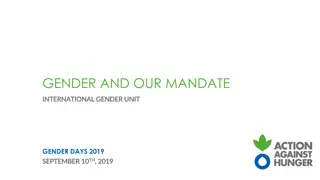Gender Equality in Australian Child Support Inquiry: Unveiling Machinations of Fairness
Australian Child Support Inquiry delves into gender inequality, unfairness, and biases within the child support system. The policy background, methods of analysis, and responses highlight the challenges faced by fathers advocating for equality and equitable treatment in child support matters.
Download Presentation

Please find below an Image/Link to download the presentation.
The content on the website is provided AS IS for your information and personal use only. It may not be sold, licensed, or shared on other websites without obtaining consent from the author.If you encounter any issues during the download, it is possible that the publisher has removed the file from their server.
You are allowed to download the files provided on this website for personal or commercial use, subject to the condition that they are used lawfully. All files are the property of their respective owners.
The content on the website is provided AS IS for your information and personal use only. It may not be sold, licensed, or shared on other websites without obtaining consent from the author.
E N D
Presentation Transcript
Gender inequality: Machinations of fairness in latest Australian Child Support Inquiry DR KAY COOK DR CHRISTINE SKINNER
Introduction Policy Background Australia De-gendering Aims & Methods Unfair - Failing & Gender Biased System Unfair No gender equality Unfair - Division of work and care Conclusion - Gender Equality V Gender Equity
Australian Policy Background Original 1998 CS system tackled lone parent (female) poverty Based male breadwinning model and redistribution of income across separated families households Fueled father s resentment led 2003 inquiry & 2005 Taskforce 2008 reforms income shares model = equal treatment 2014-15 inquiry one aim review the formula
Methods FRAME ANALYSIS Preliminary analysis explore how fathers framed problem of CS in 2014 inquiry How their gendered reality was framed more prominently than other aspects Questions: what is the basis men s claims of unfairness in the child support system? What kinds of solutions were proposed in response? Data Submissions to the Inquiry Coding of themes and identification of idea elements Total volume of witness testimony Fathers Mothers Submissions Public Hearings 130 submissions 13 sessions; 76 witnesses 55 3 13 1 Community Statement Sessions 8 sessions; 105 witnesses 65 28
Unfair- Failing & Gender Biased System Respondents framed system as: Failing fathers and children Anti-men adversarial system, totally out of control being run by feminists in the CSA Contrary to what seems to be modern feminist mantra, men are not stupid. They are not blind to a system that repeatedly treats them as second class parents, a system that reduces their contribution to their children s lives and upbringing, as a walking wallet and visitation centre (Submission 87).
Unfair - no gender equality Australian men of procreating/child rearing age have been brought up to believe in equality They believe that men and women should be both involved in raising children. They witnessed the inequalities of the day that were biased against mothers, and perhaps their older sisters. They then accepted that both genders are entitled to receive the same compensation for their efforts at work and home They see systems which have NOT kept pace with societal expectations and modern family dynamics. They see decisions which are biased against men, against them for providing an income for their families. This causes frustration, anxiety, depression and anger . (Submission 87)
Unfair - Division of work and care Remembering that the payer needs to work and obviously has more expenses than a payee sitting at home I believe that the child support formula was actually supposed to be based on both parents working and carrying their fair and equal share (Submission 112). Why should one parent work longer hours than the other parent when care level is 50%. This is not fair! (Submission 109) The issue of resident parents in receipt of high levels of support who opt to work part-time, when they could be working full-time in their current positions, be addressed (Submission 12).
Conclusion Gender Equality V Gender Equity Policy makers need sensitized to the difference. Arguments for more gender equality will not produce equal outcomes for men in CS system based on affordability and equity principle.























